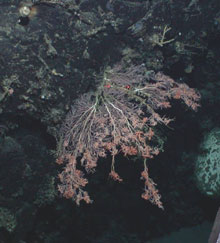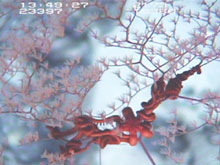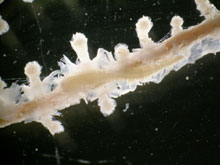
The primnoid octocoral, Candidella imbricata, serves as the substrate for a large number of brittle stars and also hosts a scale worm that lives in tunnels along the branches. Click image for larger view.
Deep-sea Octocorals as Homes for Other Species
Les Watling, PhD
Darling Marine Center
University of Maine
Octocorals are large, erect, colonial invertebrates. They have a strong skeleton covered with soft tissue, the coenenchyme (pronounced SEEN-EN-KYME). One characteristic feature of octocorals is the presence of sclerites, pieces of calcium carbonate secreted by the coenenchyme cells. The sclerites take a variety of shapes, depending on the octocoral family. Often, they are long and spindle shaped; but in some families, such as the Primnoidae, they can form a continuous armor, covering the entire surface of the colony.
Most likely, the sclerites protect the coral polyps from being consumed by predators. In shallow tropical corals, sclerites are sometimes insufficient as a defense. These coral harbor in their tissues chemical compounds, such as terpenoids, that are toxic to many predators. This defense works for the most part, but in the tropics a family of snails has evolved to deal with both the toxins and the sclerites.
Deep-sea octocorals are similar to their tropical counterparts, but we know nothing about chemical defenses in this group. So far, we have not observed snails grazing on the deep-dwelling octocorals. We do, however, find

A brittle star, genus Asteroschema, with its arms entwined around the branches of the octocoral Metallogorgia sp. The brittle star extends its arms to feed on small plankton that drift by. Click image for larger view.
several other groups of invertebrates living with the deep-sea octocorals. These non-predatory species are referred to as "commensals." Commensals use the corals for their own purposes, but otherwise cause the coral little harm.
Brittle stars commonly share a commensal relationship with octocorals. They seem to use the coral to get themselves as far off the sea floor as possible. This positioning probably helps the brittle stars to catch food particles, or small zooplankton, as they drift by. From this perspective, one might argue that the brittle stars are competing with the octocorals for food. Presently, we don’t have enough information to determine whether this is the case or not.
Two types of brittle stars live commensally with the octocorals. (We don’t yet know the total number of species.) One type has a small body disk and five very long arms. This brittle star entwines its arms around the octocoral branches, unfurling them slowly to feed. Usually one or two individuals inhabit a coral. The other type has a spiny body and relatively short, spiny arms. This brittle star usually occurs in large numbers on any one octocoral colony, often forming a conspicuous grouping along the outer edge of the coral branches.

The scale worm, Gorgoniapolynoe caeciliae, lives in tunnels along the branches of the octocoral Candidella imbricata. We believe the worm induces the coral to secrete over-sized sclerites at the bases of the polyps, which create the tunnels for the worm to inhabit. Click image for larger view.
A much rarer commensal group is the marine scale worm. These worms get their name from a series of scales that occur in pairs on their back. Scale worms are common everywhere in the ocean, from shallow water to the deep sea, and they seem to be the major worm group capable of forming commensal relationships with octocorals. That said, they are associated with only the octocorals in which the sclerites form large external plates. On Manning Seamount, we discovered that the primnoid octocoral, Candidella imbricata, was inhabited by large numbers of the small scale worm, Gorgonopolynoe caeciliae. The worm lives in a tunnel made out of enlarged sclerites at the base of the coral polyps. Somehow, the worm induces the coral to make these sclerites.
One of this year's objectives is to sample many more specimens of Candidella imbricata and attempt to answer some basic questions about the commensal relationship with the scale worm. For example, it would be very unusual for a worm to live longer than two to three years, yet most octocorals are at least 50, if not several hundred, years old. We want to know: what happens to the tunnels when the worm dies? Does the coral slough off the large sclerites, or are abandoned tunnels inhabited by newly settled worms? When do the worms reproduce, and when can we expect to see newly settling small worms? Since this cruise occurs right after the spring bloom settles on the deep-sea floor, we may see reproductively active worms.





















